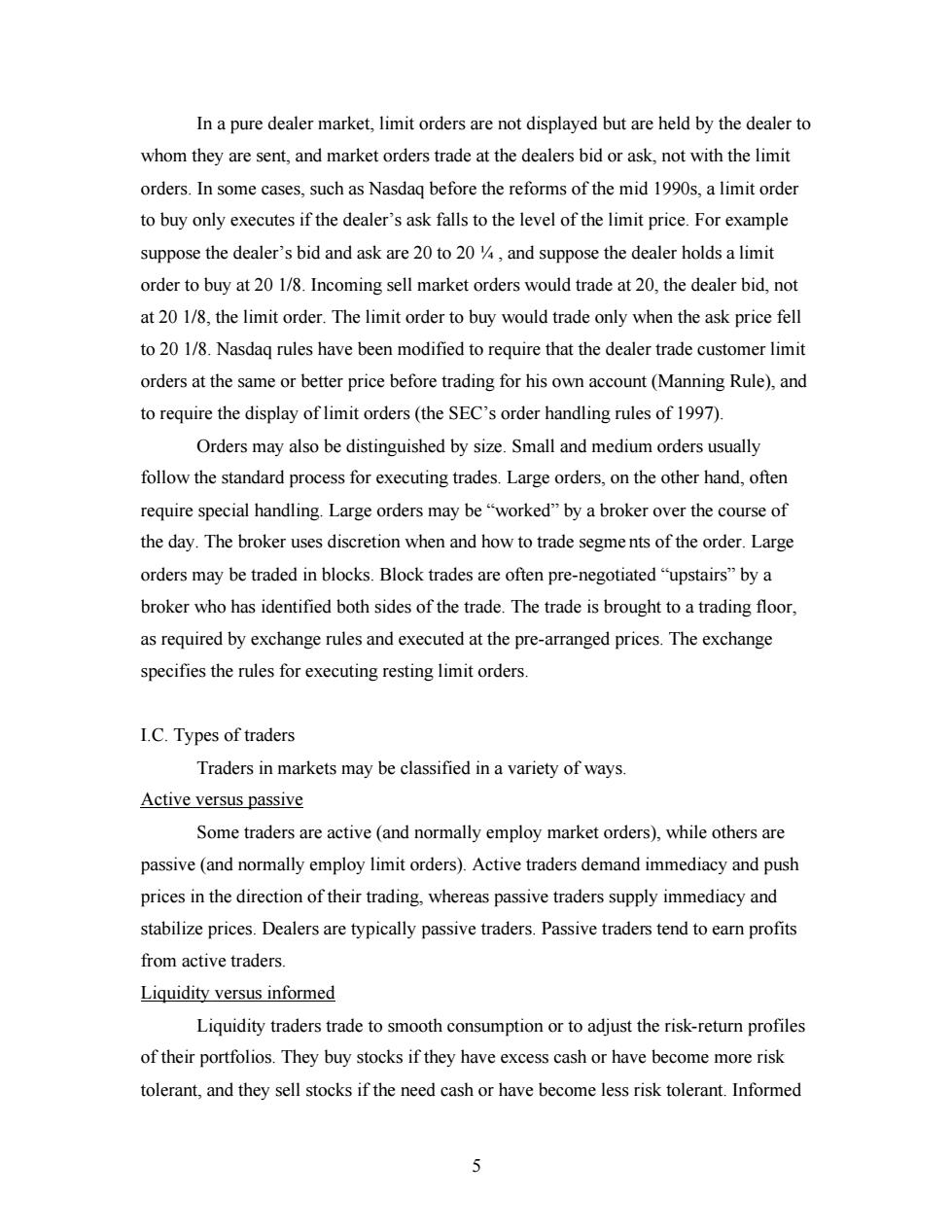正在加载图片...

In a pure dealer market,limit orders are not displayed but are held by the dealer to whom they are sent,and market orders trade at the dealers bid or ask,not with the limit orders.In some cases,such as Nasdag before the reforms of the mid 1990s,a limit order to buy only executes if the dealer's ask falls to the level of the limit price.For example suppose the dealer's bid and ask are 20 to 20,and suppose the dealer holds a limit order to buy at 20 1/8.Incoming sell market orders would trade at 20,the dealer bid,not at 20 1/8,the limit order.The limit order to buy would trade only when the ask price fell to 20 1/8.Nasdaq rules have been modified to require that the dealer trade customer limit orders at the same or better price before trading for his own account (Manning Rule),and to require the display of limit orders(the SEC's order handling rules of 1997) Orders may also be distinguished by size.Small and medium orders usually follow the standard process for executing trades.Large orders,on the other hand,often require special handling.Large orders may be "worked"by a broker over the course of the day.The broker uses discretion when and how to trade segme nts of the order.Large orders may be traded in blocks.Block trades are often pre-negotiated "upstairs"by a broker who has identified both sides of the trade.The trade is brought to a trading floor, as required by exchange rules and executed at the pre-arranged prices.The exchange specifies the rules for executing resting limit orders. I.C.Types of traders Traders in markets may be classified in a variety of ways. Active versus passive Some traders are active (and normally employ market orders),while others are passive(and normally employ limit orders).Active traders demand immediacy and push prices in the direction of their trading,whereas passive traders supply immediacy and stabilize prices.Dealers are typically passive traders.Passive traders tend to earn profits from active traders. Liquidity versus informed Liquidity traders trade to smooth consumption or to adjust the risk-return profiles of their portfolios.They buy stocks if they have excess cash or have become more risk tolerant,and they sell stocks if the need cash or have become less risk tolerant.Informed 55 In a pure dealer market, limit orders are not displayed but are held by the dealer to whom they are sent, and market orders trade at the dealers bid or ask, not with the limit orders. In some cases, such as Nasdaq before the reforms of the mid 1990s, a limit order to buy only executes if the dealer’s ask falls to the level of the limit price. For example suppose the dealer’s bid and ask are 20 to 20 ¼ , and suppose the dealer holds a limit order to buy at 20 1/8. Incoming sell market orders would trade at 20, the dealer bid, not at 20 1/8, the limit order. The limit order to buy would trade only when the ask price fell to 20 1/8. Nasdaq rules have been modified to require that the dealer trade customer limit orders at the same or better price before trading for his own account (Manning Rule), and to require the display of limit orders (the SEC’s order handling rules of 1997). Orders may also be distinguished by size. Small and medium orders usually follow the standard process for executing trades. Large orders, on the other hand, often require special handling. Large orders may be “worked” by a broker over the course of the day. The broker uses discretion when and how to trade segme nts of the order. Large orders may be traded in blocks. Block trades are often pre-negotiated “upstairs” by a broker who has identified both sides of the trade. The trade is brought to a trading floor, as required by exchange rules and executed at the pre-arranged prices. The exchange specifies the rules for executing resting limit orders. I.C. Types of traders Traders in markets may be classified in a variety of ways. Active versus passive Some traders are active (and normally employ market orders), while others are passive (and normally employ limit orders). Active traders demand immediacy and push prices in the direction of their trading, whereas passive traders supply immediacy and stabilize prices. Dealers are typically passive traders. Passive traders tend to earn profits from active traders. Liquidity versus informed Liquidity traders trade to smooth consumption or to adjust the risk-return profiles of their portfolios. They buy stocks if they have excess cash or have become more risk tolerant, and they sell stocks if the need cash or have become less risk tolerant. Informed